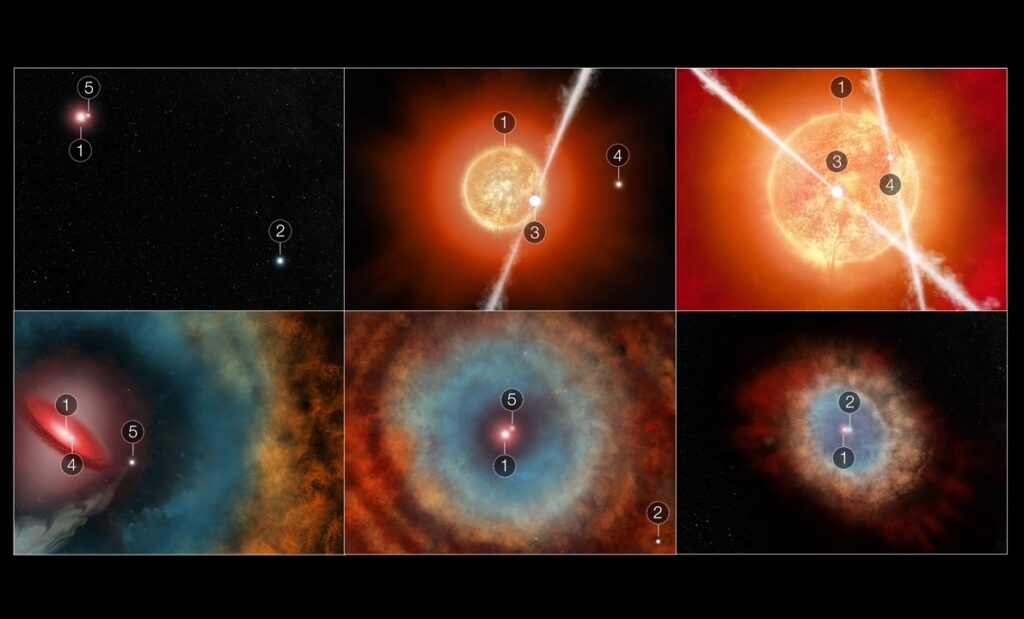How did all the “partygoers” –up to five stars– create the Southern Ring Nebula? Let’s hit “rewind” and replay the interactions that might have creat
How did all the “partygoers” –up to five stars– create the Southern Ring Nebula? Let’s hit “rewind” and replay the interactions that might have created the scene!, informed NASA.
First, it’s important to know that these illustrations are not properly scaled since some are too small and dim to appear in Webb’s image. Second, star 1 and star 2 are the only stars we see in the sixth and final panel above. The remaining “guests” will be known as stars 3, 4, and 5. They are all much less massive, in other words far smaller and dimmer, than stars 1 and 2.
1. The first illustration shows a wider field. Star 1, the most massive of this group of five stars, is the fastest to age and is responsible for creating the planetary nebula. Star 2 very slowly orbits star 1, which is easier to see in the last panel. All is relatively quiet at this stage as they orbit one another, though there is another star on the scene, number 5. It orbits star 1 far more tightly than star 2 does.

2. The second panel zooms way in on the scene, and two other companions appear in view. Star 1 has begun to swell as it ages rapidly, swallowing star 3. Through gravity, star 3 starts to draw in material from star 1 and launches jets in both directions. Star 4 is close by, but not yet interacting.
3. The third panel shows how much star 1 has expanded as it ages. Two companions also enter the mix. Stars 3 and 4 have sent off a series of bipolar jets. As these two stars interact, the jets they sent out are tumbled, which leads to the irregular, wavy edges of the gas and dust ejected by aging star 1. Both companions 3 and 4 are interacting within the gas and dust star 1 has ejected.
4. In panel 4, we zoom out to see more of the scene. Ultraviolet light and a fast, spherical wind from the newly exposed ultra-hot core of star 1 is helping to carve out its previously ejected gas and dust, creating a bubble-like cavity. There is also a leftover disk of material from the previous interactions with star 3. Star 3 is no longer visible, but star 5 is now in view. It has a wider orbit and is drawing “lines” through the ejected gas and dust from star 1 as it orbits, like a knife through a bowl of icing.
5. Now we zoom out even wider! At this stage, we’re getting closer to a view of the planetary nebula we see today. The fifth panel shows the same trio – stars 1 and 2 with star 5. Now, to mix it up again: As it orbits, star 5 continues to interact with the ejected gas and dust that slowly travels farther and farther from star 1 into the surrounding space, generating the system of large rings seen in the outer nebula.
6. The sixth panel portrays the scene as we observe it today, by zooming all the way out, we see only stars 1 and 2 in the Southern Ring Nebula.
Now you’re well oriented and informed, as reported by NASA.
All Credit to: NASA, ESA, CSA, STScI, Elizabeth Wheatley (STScI)


